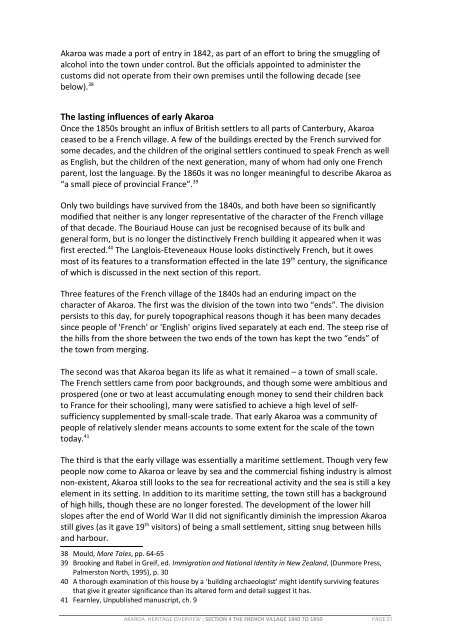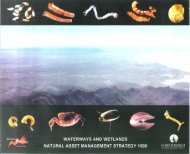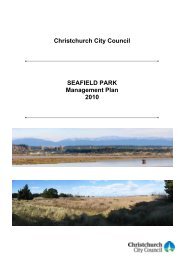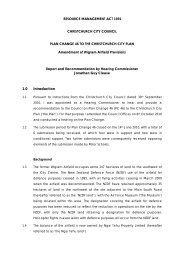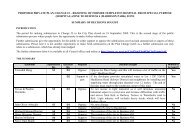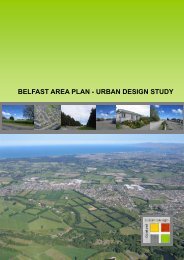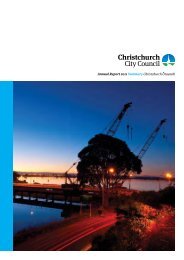Akaroa Historical Overview - Christchurch City Council
Akaroa Historical Overview - Christchurch City Council
Akaroa Historical Overview - Christchurch City Council
You also want an ePaper? Increase the reach of your titles
YUMPU automatically turns print PDFs into web optimized ePapers that Google loves.
<strong>Akaroa</strong> was made a port of entry in 1842, as part of an effort to bring the smuggling of<br />
alcohol into the town under control. But the officials appointed to administer the<br />
customs did not operate from their own premises until the following decade (see<br />
below). 38<br />
The lasting influences of early <strong>Akaroa</strong><br />
Once the 1850s brought an influx of British settlers to all parts of Canterbury, <strong>Akaroa</strong><br />
ceased to be a French village. A few of the buildings erected by the French survived for<br />
some decades, and the children of the original settlers continued to speak French as well<br />
as English, but the children of the next generation, many of whom had only one French<br />
parent, lost the language. By the 1860s it was no longer meaningful to describe <strong>Akaroa</strong> as<br />
“a small piece of provincial France”. 39<br />
Only two buildings have survived from the 1840s, and both have been so significantly<br />
modified that neither is any longer representative of the character of the French village<br />
of that decade. The Bouriaud House can just be recognised because of its bulk and<br />
general form, but is no longer the distinctively French building it appeared when it was<br />
first erected. 40 The Langlois-Eteveneaux House looks distinctively French, but it owes<br />
most of its features to a transformation effected in the late 19 th century, the significance<br />
of which is discussed in the next section of this report.<br />
Three features of the French village of the 1840s had an enduring impact on the<br />
character of <strong>Akaroa</strong>. The first was the division of the town into two “ends”. The division<br />
persists to this day, for purely topographical reasons though it has been many decades<br />
since people of 'French' or 'English' origins lived separately at each end. The steep rise of<br />
the hills from the shore between the two ends of the town has kept the two “ends” of<br />
the town from merging.<br />
The second was that <strong>Akaroa</strong> began its life as what it remained – a town of small scale.<br />
The French settlers came from poor backgrounds, and though some were ambitious and<br />
prospered (one or two at least accumulating enough money to send their children back<br />
to France for their schooling), many were satisfied to achieve a high level of selfsufficiency<br />
supplemented by small-scale trade. That early <strong>Akaroa</strong> was a community of<br />
people of relatively slender means accounts to some extent for the scale of the town<br />
today. 41<br />
The third is that the early village was essentially a maritime settlement. Though very few<br />
people now come to <strong>Akaroa</strong> or leave by sea and the commercial fishing industry is almost<br />
non-existent, <strong>Akaroa</strong> still looks to the sea for recreational activity and the sea is still a key<br />
element in its setting. In addition to its maritime setting, the town still has a background<br />
of high hills, though these are no longer forested. The development of the lower hill<br />
slopes after the end of World War II did not significantly diminish the impression <strong>Akaroa</strong><br />
still gives (as it gave 19 th visitors) of being a small settlement, sitting snug between hills<br />
and harbour.<br />
38 Mould, More Tales, pp. 64-65<br />
39 Brooking and Rabel in Greif, ed. Immigration and National Identity in New Zealand, (Dunmore Press,<br />
Palmerston North, 1995), p. 30<br />
40 A thorough examination of this house by a ‘building archaeologist’ might identify surviving features<br />
that give it greater significance than its altered form and detail suggest it has.<br />
41 Fearnley, Unpublished manuscript, ch. 9<br />
AKAROA HERITAGE OVERVIEW : SECTION 4 THE FRENCH VILLAGE 1840 TO 1850 PAGE 21


